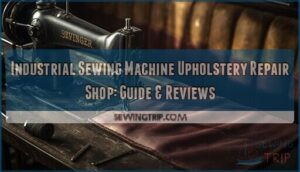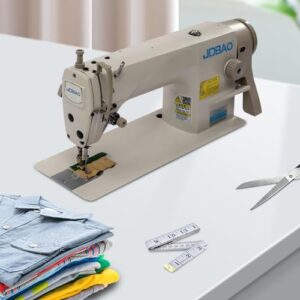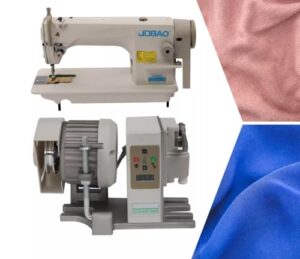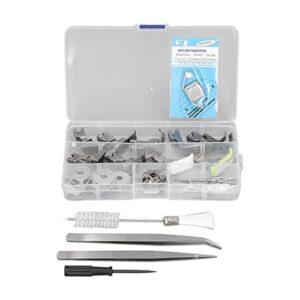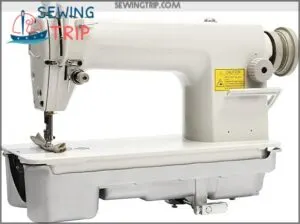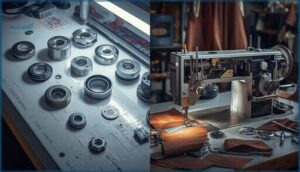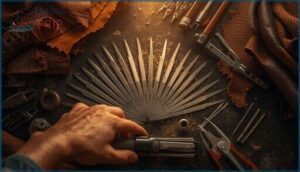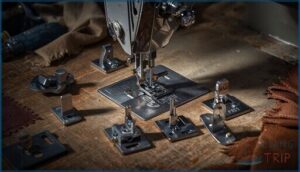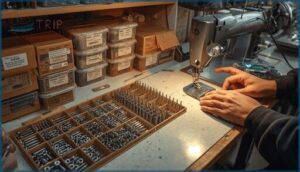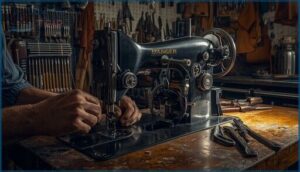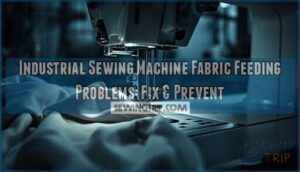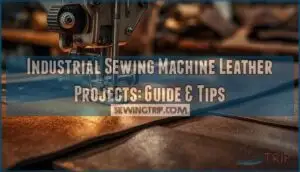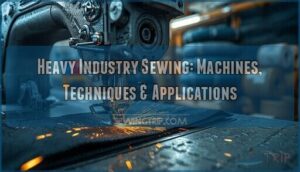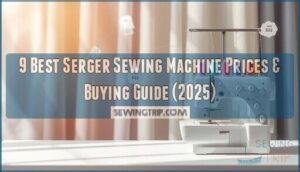This site is supported by our readers. We may earn a commission, at no cost to you, if you purchase through links.
A single broken stitch on a booth seat can shut down an entire restaurant section until repairs are done. That’s why upholstery shops can’t afford downtime when their industrial sewing machines fail. Your choice of equipment and repair support determines whether you’re running jobs smoothly or scrambling to meet deadlines.
The right machine manages everything from thin vinyl to layered leather without missing a beat, while the wrong one creates tension headaches and thread breaks that cost you money every hour.
We’ll walk through the machines that hold up under daily punishment, the parts that keep them running, and the repair services that get you back to work fast.
Table Of Contents
- Key Takeaways
- Best Industrial Sewing Machines for Upholstery Repair
- 1. Heavy Duty Leather Sewing Machine
- 2. Heavy Duty Industrial Sewing Machine
- 3. Industrial Upholstery Sewing Machine Heavy Duty
- 4. DUIBAII Industrial Sewing Machine Heavy Duty
- 5. PSUFURV Industrial Leather Sewing Machine
- 6. Industrial Sewing Machine Presser Foot Set
- 7. Industrial Leather Sewing Machine Head
- Choosing The Right Sewing Machine for Your Shop
- Industrial Sewing Machine Parts and Accessories
- Professional Sewing Machine Repair Services
- Maintenance and Support for Upholstery Shops
- Frequently Asked Questions (FAQs)
- Conclusion
Key Takeaways
- Your machine choice determines whether you’re running jobs smoothly or scrambling when equipment fails, since a broken stitch can shut down an entire restaurant section until repairs are complete.
- Machines that handle thick materials without constant thread breaks need specific features like walking foot mechanisms, servo motors delivering 3,000+ stitches per minute, and adjustable presser foot lifts up to 20mm for multiple layers.
- Preventive maintenance cuts your repair costs from $950 per breakdown to just $300 annually while reducing downtime by up to 67%, making regular cleaning and quarterly inspections essential for keeping your shop profitable.
- Stocking the right parts and establishing a relationship with repair services before problems hit means you’ll face minor delays instead of losing days of work when industrial equipment breaks down.
Best Industrial Sewing Machines for Upholstery Repair
Choosing the right industrial sewing machine can make or break your upholstery repair shop. You need equipment that won’t quit when you’re working through thick leather or multiple layers of heavy fabric.
Below are seven solid options that hold up under the demands of professional upholstery work.
1. Heavy Duty Leather Sewing Machine
A heavy duty leather sewing machine transforms how you handle thick upholstery materials. Look for models that manage leather thickness capacity up to 4mm and deliver stitch quality consistency at speeds reaching 3,000 stitches per minute. Motor power requirements generally start at 550 watts for reliable performance.
Understanding feed mechanism types—like walking foot or compound feed—makes all the difference when working leather.
Modern automation feature integration helps with precision, while regular machine maintenance keeps your industrial sewing machines running smoothly and your industrial sewing machine repair needs minimal.
Best For: Garment factories, professional upholsterers, and serious home sewers who regularly work with thick materials like leather, canvas, and heavy fabrics requiring industrial-grade durability and precision.
- Handles thick materials up to 4mm with ease thanks to heavy-duty cast iron construction and powerful motor capabilities reaching 3,000 stitches per minute
- Precision stitch control with adjustable settings (0-5mm needle pitch, 0-9mm zigzag width) gives you professional-quality results on demanding projects
- Built to last with industrial-grade components and proven reliability, backed by the kind of construction you’d find in commercial garment factories
- Requires separate purchase of motor and tabletop frame to operate, adding significant cost and complexity to initial setup
- Heavy weight (23kg net) and professional-grade design mean it’s not portable or ideal for casual hobbyists with limited space
- Assembly required and safety considerations necessary—missing parts or improper setup could lead to injury, so it demands careful attention during installation
2. Heavy Duty Industrial Sewing Machine
Most upholstery shops need machines built for demanding workloads. The GOSHET heavy duty industrial sewing machine delivers material capacity up to medium and thick fabrics with a stitch speed around 1,100 stitches per minute. Its cast iron frame durability ensures stability during long production runs. Motor power requirements average 70 watts for typical operations.
You’ll find automation options like automatic oil spraying devices reduce noise and maintenance time. Regular sewing machine service keeps your equipment performing reliably when industrial sewing machine repair becomes necessary.
Best For: Upholstery shops and alteration businesses looking for a reliable, budget-friendly machine that can handle medium to thick fabrics at industrial speeds without breaking the bank.
- Cast iron construction and double thread rotary hook deliver the durability and speed you need for high-volume production work
- Automatic oil spraying keeps noise down and maintenance simple, so you spend more time sewing and less time servicing
- At $199, it’s an affordable entry point for beginners or small shops wanting industrial capability without the typical price tag
- Lower feeding method limits you to medium and thick materials—delicate or ultra-thin fabrics won’t work well with this setup
- You’ll need to budget time for assembly and adjustment out of the box before it’s ready for production
- Even with the oil system, it’s still louder than a home machine, which might matter in smaller workspaces
3. Industrial Upholstery Sewing Machine Heavy Duty
Industrial sewing machines built for upholstery applications require specialized features you won’t find in standard models. Material handling through thick leather or vinyl necessitates presser foot lifts up to 20 mm and walking foot mechanisms that prevent shifting.
Stitch quality stays consistent across multiple layers when motor performance delivers adequate torque without stalling. Automation integration like servo motors improves heat dissipation during extended runs.
Your shop needs equipment that accommodates automotive interiors and furniture cushions without frequent sewing machine repair visits or constant sewing machine parts replacement.
Best For: Professional tailors, upholstery shops, and manufacturers who need to sew through heavy materials like leather, vinyl, and canvas at high speeds without constant breakdowns.
- Handles thick materials effortlessly with a 550W pure copper motor that delivers up to 3500 stitches per minute, making it ideal for high-volume production work.
- Built for durability with industrial-grade components that reduce maintenance needs and keep your shop running during long production hours.
- Versatile enough for automotive interiors, furniture upholstery, and marine applications with manual controls for darning, reverse stitching, and tension adjustments.
- Requires professional setup and maintenance since it ships unassembled and needs careful oil application before the first use.
- Operating noise around 30dB means it’s louder than home machines, which could be a factor in smaller workshop spaces.
- Controller settings are sensitive and shouldn’t be adjusted without expertise, limiting on-the-fly modifications for users without technical knowledge.
4. DUIBAII Industrial Sewing Machine Heavy Duty
The DUIBAII model delivers 3500 stitches per minute from a 550W pure copper motor, giving you strong stitch quality on dense materials without overheating. Your material compatibility extends from leather to heavy canvas with adjustable stitch length up to 0.2 inches. Noise level stays at 30 dB during operation.
Assembly needs include purchasing a separate table and voltage verification for the 110V system.
Regular machine maintenance keeps industrial equipment running smoothly, though you may need occasional sewing machine parts or sewing machine repair services for peak performance.
Best For: Professional tailors, upholstery repair shops, and manufacturing operations that need to handle heavy-duty materials like leather, canvas, and thick multi-layer fabrics at high speeds.
- Fast 3500 stitches per minute with a powerful 550W pure copper motor that handles dense materials without overheating or skipping stitches.
- Quiet operation at only 30 dB, making it suitable for work environments where noise is a concern.
- Adjustable stitch length and strong construction with premium materials like iron and aluminum ensure durability for professional use.
- Table must be purchased separately, adding extra cost and setup time before you can start using the machine.
- Limited to 110V voltage only, which won’t work if your shop uses different electrical standards without a converter.
- May require professional assembly and occasional maintenance or parts replacement to maintain peak performance.
5. PSUFURV Industrial Leather Sewing Machine
At 61 pounds, the PSUFURV model combines portability with PSUFURV Performance, designed for leather thickness up to seven ounces. Your stitch quality remains consistent across boots, bags, and cylindrical items through a double-thread rotating hook.
Motor compatibility requires the separate purchase of a drive unit to reach speeds up to 3,000 stitches per minute.
Maintenance tips include regular oiling using the included plate and reading the manual before assembly. For complex issues, professional sewing machine repair services handle equipment repair needs, while industrial sewing machine service providers stock compatible sewing machine parts for ongoing machine repair support.
Best For: Small upholstery shops, bootmakers, and leathergoods manufacturers who need a heavy-duty machine for thick materials like leather, canvas, and rubber.
- Handles thick materials up to seven ounces with consistent stitch quality through a double-thread rotating hook system
- Capable of high-speed operation up to 3,000 stitches per minute when paired with an appropriate motor
- Compact and relatively portable at 61 pounds, making it suitable for limited workspace environments
- Requires separate purchase of motor, tabletop rack, and frame, increasing total setup cost
- May struggle with very thin or delicate fabrics due to its heavy-duty industrial design
- Limited manufacturer support and warranty coverage compared to higher-end models, with parts sourcing left to the buyer
6. Industrial Sewing Machine Presser Foot Set
An extensive presser foot set transforms your stitching precision through variety and quality. You’ll find 32 to 68 feet engineered for cording, hemming, and piping tasks.
Shank type matters—high-shank models measure 1¼ inches and fit most machines when paired with correct adapters.
Foot material quality determines longevity: carbon steel resists corrosion across diverse textiles, while zinc alloy withstands 10,000 cycles with under 1% failure.
Routine inspection every three to six months aids upholstery stitch precision. Professional industrial sewing machine service providers offer machine adjustments and sewing machine parts when machine repair becomes necessary.
Best For: Upholstery repair shops and professional tailors who need a versatile collection of specialized feet to handle diverse stitching tasks like cording, hemming, and piping with industrial-grade precision.
- Exceptional durability with carbon steel and zinc alloy construction that withstands over 10,000 cycles with less than 1% failure rate under normal operation.
- Broad compatibility across major industrial machine brands including Juki, Singer, and PFAFF when paired with appropriate adapters for high-shank systems.
- Cost-effective solution with complete sets ranging from $70-$140, offering 32-68 specialized feet that reduce the need for individual purchases and improve organizational efficiency.
- Compatibility isn’t universal—requires verification of shank type and needle width settings, with some machines needing additional adapters or minor adjustments for proper fitting.
- Installation demands proper technique and may require extra tools, which can be challenging for users without prior experience or technical guidance.
- Plastic components in multi-purpose sets have limited durability for heavy-duty tasks and risk deformation under stress compared to metal alternatives.
7. Industrial Leather Sewing Machine Head
A machine head rated at 30 to 34.5 kg delivers the torque needed for thick leather layers. Head durability spans 10 to 20 years under proper maintenance, with premium units exceeding 30 years.
Automation integration now includes touchscreens and programmable patterns, reflecting current market trends in upholstery applications. Semi-automatic lubrication extends functional life by 35%.
When machine repair becomes necessary, professional sewing machine repair services provide sewing machine parts and industrial sewing machine service to keep your equipment running smoothly.
Best For: Professional seamstresses, upholstery shops, and serious crafters who regularly work with thick leather, canvas, and heavy-duty materials and need a machine that can handle industrial workloads.
- Built to last 10-20 years with regular maintenance, and premium models can run for over 30 years, making it a solid long-term investment for your workshop.
- Handles thick leather layers up to 0.5cm with adjustable gauge and reverse stitch, plus it works great on bags, upholstery, and canvas projects.
- Modern features like semi-automatic lubrication and compound feed mechanisms reduce maintenance hassle and prevent fabric shifting during heavy-duty sewing.
- Motor, table rack, and safety devices sold separately, so you’ll need to budget extra and potentially hire someone with technical know-how for installation.
- At 28kg (61 lbs), it’s a hefty piece of equipment that requires a dedicated workspace and isn’t easy to move around.
- Requires a motor over 550W to run properly, which adds to the upfront cost and may increase your electricity usage compared to lighter domestic machines.
Choosing The Right Sewing Machine for Your Shop
Picking the right sewing machine for your upholstery shop isn’t just about power and speed. You need to match the machine to the materials you work with most and the types of repairs that come through your door.
Let’s walk through the key factors that’ll help you make a choice you won’t regret.
Key Features for Upholstery Applications
When you’re choosing an industrial sewing machine for upholstery work, you need features that handle thick materials without breaking a sweat. Here’s what matters:
- Motor power with servo controls that push through multiple layers at consistent speeds up to 3,300 stitches per minute
- Feed mechanisms like walking foot or compound feed that prevent slippage on heavy fabrics
- Stitch quality with adjustable lengths up to 10mm for decorative and structural seams
- Bobbin management systems with large capacity to minimize thread changes during big projects
- Automation features including programmable controls and thread trimmers that speed up production
These features help your machine repair and sewing machine service needs stay minimal while handling automotive upholstery and furniture work. Industrial machines offer adjustable foot pressure for precise control. Industrial sewing machine brands like Juki and Union Special build these capabilities into their models, and sewing machine parts availability keeps you running when repairs are needed.
Comparing New Vs. Used Industrial Machines
When you’re weighing new machines against used machines for your shop, initial cost tells just part of the story. New industrial sewing machines run $2,500 to $5,000, offering warranty coverage and modern technology differences like servo motors.
Used options cost 40% to 60% less but bring higher maintenance needs and depreciation rates that flatten out. Energy-efficient motors can reduce power consumption.
Industrial sewing machine sales offer both paths—your volume determines which fits.
Popular Brands: Juki, Union Special, Eastman, Durkopp Adler, Merrow
Five brands dominate upholstery applications through brand specialization you can trust.
- Juki commands 18% market share with global reach across 185 countries
- Union Special brings 143 years of heavy-duty heritage since 1881
- Eastman delivers cutting innovation for high-output shops
Durkopp Adler excels in automotive upholstery, while Merrow manufactures 360+ serger models. Brand comparison shows these leaders drive future trends in industrial sewing machine markets.
Evaluating Machine Durability and Performance
Beyond brand names, performance tells you whether a machine earns its place in your shop. Lifespan benchmarks for upholstery machines span 15 to 25 years under proper care. Performance metrics like 3,000+ stitches per minute and handling 10 layers of leather separate true workhorses from pretenders.
| Metric | Industrial Standard |
|---|---|
| Speed Range | 3,000–5,000 stitches/min |
| Material Capacity | Up to 10 layers leather |
| Stitch Tolerance | ±0.5 mm consistency |
Failure statistics reveal hook assemblies cause 40% of machine issues. Material compatibility with 210–340 denier thread matters for heavy canvas repairs. Shop conditions demand machines surviving continuous daily operation.
Preventive machine servicing cuts downtime by 50%, while neglected machine parts accelerate bearing wear by 60%. These numbers guide smart machine adjustments before breakdowns strike.
Industrial Sewing Machine Parts and Accessories
Your sewing machine won’t run long without the right parts on hand. From needles and blades to presser feet and replacement heads, keeping your shop stocked means less downtime when something wears out or breaks.
Here’s what you need to know about sourcing parts and accessories for your industrial upholstery equipment.
Genuine OEM Vs. Aftermarket Parts
You face a decision every time a part breaks. OEM parts cost 30–50% more than aftermarket options but deliver 20% longer machine lifespan and 17% less downtime. Aftermarket parts offer immediate cost savings yet raise failure rates by 35% within six months.
Consider three factors:
- Warranty Coverage – Most manufacturers void warranties if aftermarket parts cause failures
- Performance Impact – OEM parts reduce skipped stitches and alignment errors by 28%
- Compatibility Issues – Aftermarket installations face mismatches 14% of the time
Your sewing machine parts availability matters less than long-term reliability. Quality sewing machine parts and service protect your investment.
Manual Knife Blades and Needles
Quality blades and needles are essential for achieving precise output. High-carbon steel blades with chromium content offer excellent wear resistance during continuous cutting. Regular needle replacement every eight hours of operation is crucial to prevent thread breakage and ensure even stitching.
| Component | Specification |
|---|---|
| Blade Sizes | 6–10 inches |
| Blade Thickness | 0.06–0.40 mm |
| Needle Change | Every 8 hours |
| Cutting Depth | Up to 3 inches |
| Safety Features | Retractable designs |
Modern safety blades significantly outperform traditional options, lasting up to 11 times longer. Additionally, sewing machine parts with ergonomic designs are available, helping to reduce hand strain during fabric preparation.
Presser Foot Sets and Sewing Machine Heads
Once your needles and blades are ready, matching the right presser foot to your sewing machine head determines stitch quality and material feed. High-shank industrial machines—measured at 1¼ inch clearance—dominate upholstery repair shops because of foot compatibility.
Consider these proven options:
- 32-piece sets ($76.99) for set versatility across zipper and hem work
- P351 standard feet (5 mm edge) for precise straight stitching
- Teflon and gathering feet for heavy leather projects
Always power off before switching feet to prevent injury during sewing machine repairs.
Parts Availability for Major Brands
When you order OEM parts for Pfaff or Singer machines, expect up to three weeks. Aftermarket quality fills gaps faster—often under five days through AllBrands and regional sourcing networks.
Brand compatibility matters: over 60% of legacy models run on aftermarket stock while current lines lean OEM.
Smart inventory management cuts downtime by 35%, so balance both sewing machine brands and parts types in your shop.
Professional Sewing Machine Repair Services
Professional Sewing Machine Repair Services
Even the toughest industrial machines break down. When your equipment fails, you need a repair shop that understands upholstery work and won’t waste your time.
Here’s what separates reliable repair services from the rest.
Free Repair Estimates and No-appointment Service
You want a repair estimate that’s honest and fast. Over 70% of specialized shops now offer free repair estimates with no appointment required, and walk-in service cuts your wait to about 18 minutes.
Estimate transparency matters—itemized breakdowns show labor and parts separately, with cost deviation under 9%. Policy compliance protects you, so shops with free estimates and walk-in benefits handle 13% more commercial repairs monthly.
In-house Vs. Outsourced Repairs
When weighing in-house repair services against outsourced sewing machine repair services, cost savings and downtime reduction drive the decision. In-house teams offer control and quick turnaround for routine fixes, yet outsourced industrial sewing machine service brings specialized skills availability and scalability options without hiring permanent staff.
Onsite repair service providers handle compliance risks through documented preventive checks, cutting equipment downtime by up to 50%.
Supported Brands and Models
Most repair shops maintain support for 8 distinct manufacturers on average, with Juki serviced by over 85% of upholstery specialists and Brother covered by 9 out of 10 facilities. PFAFF, Consew, and Mitsubishi round out the most commonly accepted brands.
Cross-brand expertise among certified technicians reduces warranty issues by 27%, ensuring you’ll find qualified service regardless of your machine model.
Fast Turnaround and Expedited Repair Options
When your machine goes down, you need answers fast. Expedited service options can deliver same-day or next-day turnaround for premium rates, though most shops complete standard repairs in 3 to 5 business days. Parts inventory impact matters—over 90% of fixes happen immediately when components are in stock.
Diagnostic speed and communication transparency set top in-house repair services apart, with free estimates and warranty implications explained upfront. Quick sewing machine repair keeps your shop running.
Maintenance and Support for Upholstery Shops
Keeping your industrial sewing machine running smoothly takes more than fixing problems when they happen. Regular maintenance keeps downtime low and your shop profitable.
Here’s what you need to know about maintaining your equipment and getting the support you need to keep working.
Preventive Maintenance Procedures
Preventive maintenance procedures protect your investment and cut downtime by up to 67%. Daily machine cleaning removes lint and thread debris from bobbin cases and feed dogs. Weekly machine lubrication at designated points keeps components running smoothly.
Quarterly equipment inspection covers timing calibration and tension disc cleaning. Annual preventive scheduling includes deep cleaning, worn part replacement, and full machine calibration.
Proper preventive maintenance reduces maintenance costs from $950 per breakdown to just $300 annually while reducing downtime considerably.
Preventive maintenance slashes your repair costs from $950 per breakdown to just $300 annually while keeping machines running
Machine Setup and Operator Training
Your sewing machine technician’s experience matters during on-site setup. Proper machine calibration and operator training boost efficiency from 54% to nearly 60%.
Training programs reduce errors and enhance productivity through standardized machine adjustments. Invest in targeted operator training to cut cycle times and improve throughput.
The right machine setup and training foundation keeps your upholstery shop competitive and reduces costly rework.
Warranty and Shipping Information
Once your setup and training are complete, understanding warranty and shipping information protects your investment. Most industrial machines carry 90-day to one-year warranty periods on parts and labor. Shipping insurance safeguards equipment in transit, while return authorizations simplify any damage claims.
- Average lead times run 7–10 days for order processing
- Return authorizations are mandatory before sending equipment back
- Shipping insurance covers up to $250,000 for heavy machinery
- Warranty service excludes damage from abuse or improper installation
Customer Service and Ongoing Technical Support
Beyond warranty coverage, ongoing technical support keeps your machines running smoothly. Most upholstery shops report response times under 24 hours for urgent issues, and remote diagnostics resolve 58% of problems without a service technician visit.
Direct sales channels achieve 80% issue resolution on first contact. Factory-trained technicians and service contracts with annual check-ups reduce downtime, while customer feedback improves support quality year over year.
Frequently Asked Questions (FAQs)
How much space does an upholstery shop need?
Most upholstery shops operate comfortably in 1,000 to 2,500 square feet. You’ll need room for industrial sewing machine stations, cutting tables, material storage, and workflow optimization—plus pathways that keep your repair shop running efficiently.
What licenses are required to operate a shop?
You’ll need business registration with your state, a local business permit, and possibly an occupational license depending on your location.
Federal regulations and zoning compliance also apply to upholstery repair service operations.
How do you price upholstery repair services?
Pricing repair service work isn’t rocket science. Start with your labor costs per hour, add material expenses, then factor in equipment overhead. Build profit margins into your cost estimation while staying competitive with local sewing shops.
Whats the average startup cost for a shop?
Starting a shop generally runs $20,000 to $50,000, covering facility costs, sewing equipment, initial investment in inventory, and operating reserves. Dealers and manufacturing business owners often enter with equipment expenses around $3,000 minimum.
How do you find suppliers for fabric materials?
You can source fabrics through online wholesale markets, supplier networks at trade shows, and local distributors.
Contact manufacturers directly in major textile regions for competitive pricing and material quality that meets your manufacturing business needs.
Conclusion
Ironically, the machines built to handle the toughest materials need the gentlest care to stay running. Your industrial sewing machine upholstery repair shop thrives when you match the right equipment to your workload and lock in reliable repair support before problems hit.
The shops that stay ahead don’t wait for breakdowns—they plan for them. Invest in quality machines, stock essential parts, and keep a trusted repair service on speed dial. That’s how you turn potential downtime into just another Tuesday.
- https://www.archivemarketresearch.com/reports/industrial-sewing-machines-433654
- https://straitsresearch.com/report/industrial-sewing-machine-market/united-states
- https://www.marketresearchfuture.com/reports/industrial-sewing-machines-market-24644
- https://www.linkedin.com/pulse/industrial-fabric-sewing-machine-market-size-3kgmc
- https://www.ibisworld.com/united-states/employment/furniture-repair-reupholstery/1713/

